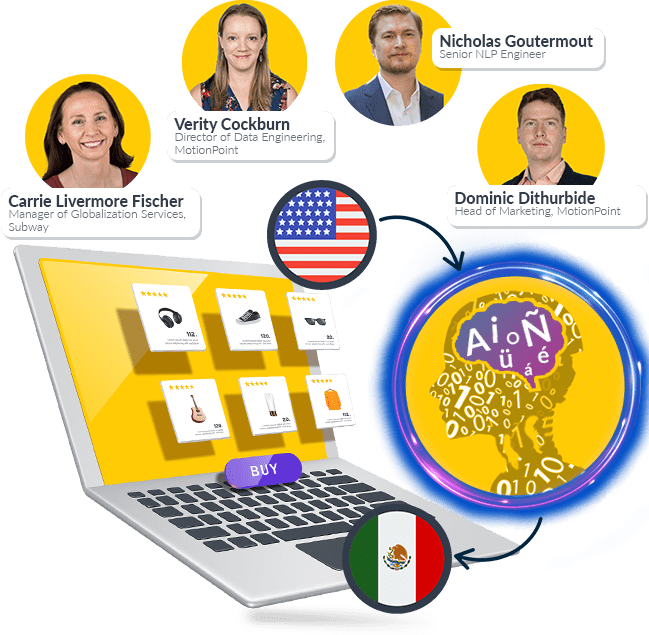Companies that are hungry to engage new online markets can often overthink their expansion plans—and short-circuit their chances for success in the process.
We’ve sometimes found that brands want to invest an inordinate amount of effort and resources in an “all in” approach to launching translated websites to serve new international customers. Keen to master the market long before entering it, this approach usually results in a pricey pursuit of a “perfect” on-site experience.
This approach makes a kind of sense, particularly for brands that are accustomed to having authoritative knowledge and a commanding position in their home markets. But there are several risks to this aggressive online expansion approach, particularly its costly nature—and the fact that, as many executives and managers know, there’s no such thing as a “perfect” shopping experience when a website debuts (no matter what market it might be serving).
These mismanaged expectations often lead to misjudgments about a global market’s viability, which can lead to abandoning the market too hastily—long before its global wesbite had a chance to prove profitable.
It takes time and patience to establish a brand in a new market.
Indeed, a more incremental, profits-driven approach is the smart play when expanding online. With this approach, a company’s ultimate goal remains to be successful in-market … but it embraces a methodology of iteration and investment (such as in-market digital marketing or localized PPC) only as quickly as in-market results will justify.
Put another way: Investment is certainly necessary to get the ball rolling in a new market. But key investments are better made once your brand has had the time to establish a presence, identify authentic in-market messaging opportunities, adapt to the market’s unique conditions, and recalibrate your business case with actual results.
We call this profit-driven approach the “Crawl, Walk, Run” method of engaging new markets.
Step 1: Crawl
MotionPoint has more than 15 years of experience helping companies expand into new online markets. We invented or pioneered most of the best practices our industry regularly uses today. Our experience suggests that before brands invest in optimizing the traffic and conversion on their global sites—or perhaps even investing in a translated global site at all—they should start slow and determine their capability to complete far simpler tasks, such as fulfilling orders to customers in these markets. In the early days serving a new market, companies can lean on third-party logistics solutions to handle distribution and fulfillment. These solutions can accommodate warehousing and shipping from overseas markets, or can handle international shipping from U.S.-based businesses.
In-market order fulfillment is a must-have to properly serve new customers, regardless of where they live. One of our clients, ASOS, has mastered fulfillment in ways that make it an industry leader—and keeps its global customers coming back.
Displaying prices in a market’s local currency is also critical, as is providing a crystal-clear landed cost. This is the total price of the product once it has been delivered. It includes “the original price of the product, all transportation fees (both inland and ocean), customs, duties, taxes, insurance, currency conversion, crating, handling and payment fees,” states a Pitney Bowes blog post.
Once an expanding company can accommodate these must-haves, it’s ready to embrace more robust strategies to boost awareness and sales in their new global markets.
Step #2: Walk
Here’s where things get interesting. The “walk” phase of a company’s new-market engagement includes such powerful approaches as:
Translating Online Content
Exchanging ideas and information in a common language is the most resonant way to build consumer trust in global markets. It also greatly reduces friction and streamlines the transactional experience.
Take one of our travel clients, which now serves the Chinese market with a transactional site. Simply launching a site in the market’s preferred language saw immediate results: traffic surged by 73%, and conversions grew by 135%. Ninety days after we translated a retailer’s site for the Italian market, the site’s transaction revenue increased by 7,944%.
For another retailer’s site serving the U.S.-based Spanish-speaking market, transaction revenue skyrocketed an astounding 23,000% a mere 90 days after its debut. Engagement metrics also went through the roof: Spanish-speaking consumers now spend an average (and astonishing) 10 minutes on the translated site.
Supporting Local Payment Types
Overseas markets often have locally-preferred payment types ranging from local bank cards to e-wallet platforms and more. Companies that fail to support these market-specific platforms often experience reduced traffic, engagement and conversion on their global sites.
Customers simply won’t transact on sites that don’t cater to their preferred payment types. In South Korea, a company can lose up to 80% of the revenue it’d otherwise generate, simply by not supporting local platforms.
In contrast, sales skyrocket when companies integrate these platforms. Take one of our retail clients, which offered the popular e-wallet platform Alipay as a payment option on its Chinese site. Days after its debut, conversions grew nearly 220%. Basket size grew by 33%. Revenue grew by 210%.
When another client supported the locally-preferred iDeal payment platform in the Netherlands, sales increased dramatically. The Dutch site generated 377% higher sales on iDeal than on MasterCard and Visa combined.
Other Local Solutions
This stage in your market maturity might provide a good opportunity to examine in-market support solutions such as warehouses, viability for brick-and-mortar locations, and more.
Step #3: Run
We’ve found that the “Run” stage of a company’s new-market journey is where the overwhelming value of a global site really shines. No longer encumbered by implementing the mission-critical tasks of speaking the market’s language or integrating preferred payment methods, companies can now optimize the user experience for their global sites—which maximizes engagement and conversions.
The “Run” stage of global online expansion is often overlooked by businesses, mostly because they focus their attention of the obvious needs of translation and order fulfillment. But global sites require the same kind of optimizations that a company’s primary-market site supports: intuitive navigation, sitemaps, on-site promotional campaigns, geo-based customize content and more.
These technologies and tactics can help foreign companies gain a competitive edge in local markets:
EasyLink® Management
MotionPoint’s EasyLink Management technology welcomes first-time visitors in the language they are most likely to speak. It also anticipates visitors’ other preferences, including appropriate country of residence and currency. It remembers these preferences on return visits, too. EasyLink often increases traffic to local websites by over 80%, and increases conversion rate by 16%.
On-Site Search Management
This technology improves a customer’s experience—and increases a global site’s conversion—by providing on-site search functionality in their preferred language. This gets customers to the products and information more quickly, which reduces bounce rates, and boosts conversions.
Global Sitemap Management
When international customers search on their local search engines, Global Sitemap Management ensures the right version of a brand’s global website appears in those results. It also preserves brand equity by presenting those translated pages with the same high relevance and rank of a company’s primary-market site.
Other Customizations
Companies can also greatly benefit from optimizing their product selections in specific markets during specific times of the year. There are great disparities in summer temperatures, for instance, between the northern and southern hemispheres. Even countries within the same continent have cultural nuances and product preferences that should be catered to, whenever possible.
Further, global sites should leverage localizations—customized website elements with highly relevant market-specific offers or verbiage—whenever possible to increase conversion rates and other key user behaviors. Localized Conversion Rate Optimization campaigns should also be embraced.
Wrapping Up
Entering a new global market online is rarely a “slam dunk” for expanding companies. Establishing brand awareness and trust—and then maximizing traffic and on-site conversions—takes time. It’s a methodical process. However, MotionPoint’s technologies and expertise can really increase a new brand’s visibility in local markets.
Does your company need insights on how to Crawl, Walk and Run in new markets? Contact us to learn how we can help you expand quickly and cost-effectively … and then provide a methodology to help you achieve sustained success.
Last updated on September 15, 2016


